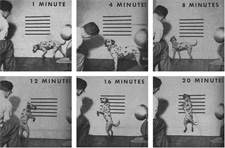 8) Reward-based reinforcement learning can explain much of behavior (Skinner – 1938, Thorndike – 1911, Pavlov – 1905)
8) Reward-based reinforcement learning can explain much of behavior (Skinner – 1938, Thorndike – 1911, Pavlov – 1905)
B. F. Skinner showed that reward governs much of human and animal behavior. He discovered operant conditioning, a method for manipulating behavior so powerful he could teach a pigeon to bowl (or a dog to jump on command; see figure). This was an expansion of Thorndike's Law of Effect, which says that behaviors associated with a reward will be reinforced, while behaviors associated with no reward will not. Both Skinner and Thorndike expanded on earlier work by Pavlov, which showed that some reflexes can be conditioned using paired stimulus presentation (e.g., a bell with food later causes salivation to a bell alone).
Implication: The mind, largely governed by reward-seeking behavior, is implemented in an organ with distributed and modular function consisting of excitatory and inhibitory neurons communicating via electro-chemical synaptic connections.
[This post is part of a series chronicling history's top brain computation insights (see the first of the series for a detailed description)]
-MC
